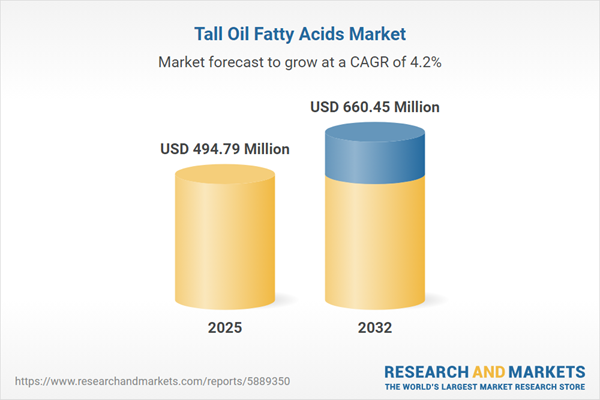Speak directly to the analyst to clarify any post sales queries you may have.
Senior decision-makers are turning to tall oil fatty acids as a reliable foundation for strengthening sustainability strategies and enhancing procurement transparency across multiple industries.
Market Snapshot: Tall Oil Fatty Acids Market Growth and Potential
The global tall oil fatty acids market is projected to sustain steady expansion through 2032, reaching a compound annual growth rate (CAGR) of 4.21%. The ongoing shift toward renewable chemical feedstocks, coupled with heightened attention from regulatory bodies and stakeholders, fuels this upward trend. Organizations in critical segments like coatings, lubricants, and personal care are adopting tall oil fatty acids to achieve operational security and sustainability benchmarks. Technology partnerships in the sector are facilitating innovation and procurement efficiency, pressing business leaders to incorporate resilience and long-term environmental considerations into their strategies.
Tall Oil Fatty Acids Market: Scope & Segmentation
- Applications: Tall oil fatty acids are integral in asphalt additives, various coatings, industrial lubricants, metalworking fluids, detergents, and personal care products. Their adoption helps businesses reduce reliance on petrochemical-based inputs and advance environmental priorities across manufacturing and end-use operations.
- Product Types: Available as crude, distilled, and hydrogenated forms, tall oil fatty acids meet a range of technical challenges, from process adaptability to performance optimization, supporting both general manufacturing and specialized requirements.
- End Use Industries: Sectors including agriculture, automotive, construction, packaging, and textiles use these materials to enhance resource stewardship and improve overall operational efficiency by leveraging renewable alternatives.
- Grades: Industrial, pharmaceutical, and technical grades support regulatory alignment, facilitate compatibility with diverse manufacturing needs, and ensure proper integration within highly regulated environments.
- Distribution Channels: Sourcing occurs via direct supplier contracts, trusted regional distributors, and digital procurement tools, allowing organizations to establish flexible sourcing plans and build resilient supply chains responsive to shifting market needs.
- Region Coverage: The tall oil fatty acids supply network spans the Americas, including the United States, Canada, Mexico, Brazil, Argentina, Chile, Colombia, and Peru, and extends to prominent markets in Europe, the Middle East, Africa, and Asia-Pacific—delivering both regional and global procurement capabilities.
- Key Companies: Leading suppliers such as Domsjö Fabriker AB, Kraton Corporation, Arizona Chemical Company, Eastman Chemical Company, TNJ Chemical Industry Co., Kolb GmbH, Arkema S.A., Innospec Inc., Evonik Industries AG, and BASF SE provide consistent supply performance and technical support for end-users.
Key Takeaways for Senior Decision-Makers
- Tall oil fatty acids offer an effective way for organizations to enhance supply chain transparency, refine procurement strategies, and meet evolving global compliance standards.
- Technological advancements, such as hydrogenation and modern separation techniques, are expanding application potential, especially in high-performance sectors such as specialty coatings and industrial emulsions.
- Reliable supplier partnerships are essential for building agility in response to regulatory shifts and minimizing procurement-related risks in volatile environments.
- Collaboration throughout the value chain—including pulp producers, refiners, and downstream end-users—maximizes resource efficiency and supports closed-loop sustainability practices.
- Comprehensive regional distribution networks enable businesses to swiftly adapt sourcing approaches, supporting uninterrupted operations and responsive decision-making as regulatory or market landscapes evolve.
Tariff Impact: U.S. Tariffs Reshape Tall Oil Fatty Acid Trade Flows
Anticipated U.S. tariffs in 2025 are influencing procurement frameworks across industries, leading companies to pursue domestic sourcing strategies and strengthen ties with regional suppliers. This dynamic encourages exploration of vertical integration, helping organizations secure steady supply, bolster compliance readiness, and manage expenses in the renewable chemical market.
Methodology & Data Sources
The insights in this report are based on executive interviews, regulatory analysis, and global trade data reviews. Scenario evaluation and capacity assessments inform market positioning and entry strategy decisions.
Why This Report Matters
- Provides actionable information to support wise investment choices, proactive risk mitigation, and the formation of sound market entry strategies.
- Assists procurement teams in navigating the implications of tariffs, ensuring resilience across both global and regional sourcing networks.
- Promotes adaptive procurement and digital sourcing practices, addressing the shifting landscape of compliance and regional industry needs.
Conclusion
This report equips senior leaders to proactively plan for market evolution, integrate sustainability into procurement, and maintain agility when navigating change.
Additional Product Information:
- Purchase of this report includes 1 year online access with quarterly updates.
- This report can be updated on request. Please contact our Customer Experience team using the Ask a Question widget on our website.
Table of Contents
3. Executive Summary
4. Market Overview
7. Cumulative Impact of Artificial Intelligence 2025
Companies Mentioned
The companies profiled in this Tall Oil Fatty Acids market report include:- Domsjö Fabriker AB
- Kraton Corporation
- Arizona Chemical Company, LLC
- Eastman Chemical Company
- TNJ Chemical Industry Co., Ltd.
- Kolb GmbH
- Arkema S.A.
- Innospec Inc.
- Evonik Industries AG
- BASF SE
Table Information
| Report Attribute | Details |
|---|---|
| No. of Pages | 198 |
| Published | November 2025 |
| Forecast Period | 2025 - 2032 |
| Estimated Market Value ( USD | $ 494.79 Million |
| Forecasted Market Value ( USD | $ 660.45 Million |
| Compound Annual Growth Rate | 4.2% |
| Regions Covered | Global |
| No. of Companies Mentioned | 11 |









